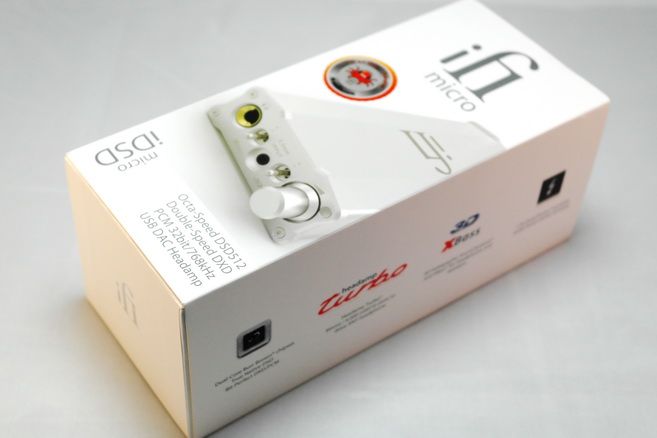
Spec
DAC:
Dual Burr Brown DAC, custom interleaving for maximum SNR
Clock: Ultra low jitter GMT computer controlled Femto Clock (RMS jitter 12kHz – 1MHz, less than 280 Femtoseconds)
Selectable Filter:
PCM (digital): Bit-Perfect Processing/Minimum Phase/Standard
DSD (analog): Extreme/Extended/Standard Range
DXD (analog): Bit-Perfect Processing
Full Native Decoding:
DSD 512/256/128/64 (24.6/22.6/12.4/11.2/6.2/5.6/3.1/2.8Mhz)
DXD 2x/1x (768/705.6/384/352.8kHz)
PCM 768/705.6/384/352.8/192/176.4/96/88.2/48/44.1kHz
Dynamic Range (Line): over 117db(A)
THD & N (0dBFS Line): under 0.003%
Output Voltage (Line): over 2V
Output Impedance (Zout): under 240Ω
Jitter (correlated): Below AP2 test set limit
Headphone-out:
Selectable:
Power mode: Eco, Normal and Turbo
Polarity: Normal / Inverted
Filters: see DAC spec
iEMatch: Off / High Sensitivity / Ultra Sensitivity
Power (max) / (continuous.)
- Turbo mode: (10.0V max) 4000 mW @ 16 Ohm / over 1560 mW @ 64 Ohm
- Normal mode: (5.5V max) 1900 mW @ 16 Ohm / over 950 mW @ 32 Ohm
- Eco mode: (2.0V max) 500 mW @ 8 Ohm / over 250 mW @ 16 Ohm
Dynamic Range: over 115dB(A) (Eco Mode, 2V Out)
THD &N (500mW/16R): under 0.008%
Output Voltage: over 8V (Turbo Mode)
Output Impedance (Zout): under 1Ω (iEMatch not engaged)
Input:
USB 2.0 type A
Built-in iPurifier, all major OS (*MacOSX, Windows, Linux) support. OTG supports: Apple portable devices with iOS 7+ and camera connection kit and selected Android devices with USB OTG cable.
S/PDIF
Coax and optical in, PCM up to 192kHz.
Analog in
3.5mm stereo jack
Output:
S/PDIF
Coax-out, PCM up to 192kHz
RCA
User selectable line (direct) or variable (preamp, with 9dB gain) output
Headphone out
6.4mm stereo jack
SmartPower® Socket: For recharging USB device (BC1.2 supported, 5V @ 1.5A)
EQ: X-Bass and 3D Holographic Sound, separated output for speaker (RCA preamp mode) and headphone-out.
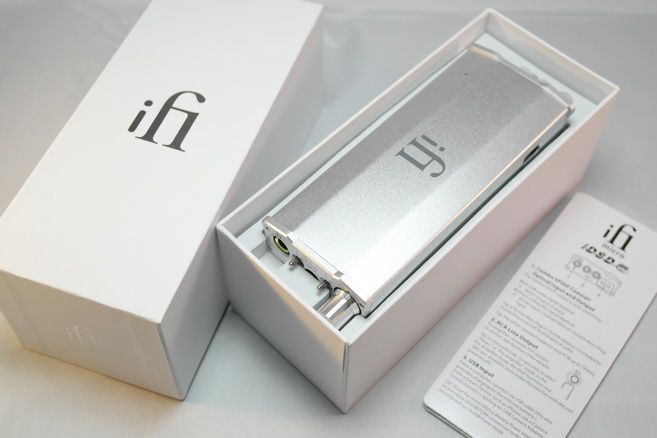

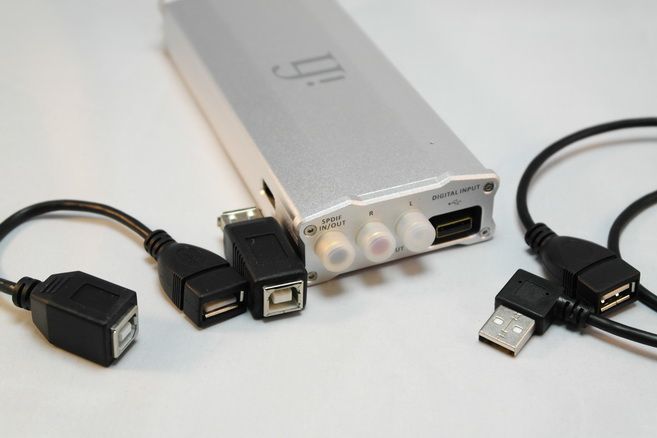
Accessories and Build Quality
Just about everything you need are included with the micro iDSD. You will get two rubber bands (for strapping a portable source to the iDSD), a short RCA-to-RCA cable, a short 3.5mm interconnecting cable, 4 stick-on rubber feet, an 1m USB 3.0 cable, a 1 foot USB cable with right angled plug (presumably for the SmartPower socket), a 6.4mm-to-3.5mm stereo adapter, a TOSlink adapter, a soft pouch, a small silicone mat (for cushioning between iDSD and your portable source), plug two USB type A female to type B female adapter (just in case you don’t want to use the included USB 3.0 cable but instead opt for your own USB type B cable, which is commonly known as the USB cable for printer and desktop USB device). Perhaps the only thing missing is either an OTG cable or camera connection kit, depends on whether you are an Android or Apple user. But those should be sourced by your own.
As with all iFi’s gears, build quality is quite excellent, though I do have some very minor complaints. The first is the more obvious – the housing is not exactly portable friendly, even though it is consistent with the micro series. You will want to put micro iDSD (along with its source) inside a small messenger bag or backpack rather than inside your pocket. The second is the tiny switches on the iDSD isn’t extremely firm and can be moved accidentally if it is in a very tight place (which makes it even less idea to put inside a pocket). It isn’t really that much of an issue as long as it is not in tight places though it is something to pay attention to. You won’t want to get caught off guarded when the gain switch is pushed from Eco to Turbo without you knowing it, for an example. A good practice is just not to store your micro iDSD with a lot of other stuff together. Having the rubber band on the body also help to keep things away. Last but not least, and I am just nit-picking here, is to have a less protruding 6.4mm-to-3.5mm adapter. The included adapter works just fine, but I do think a lower profiled adapter really works better.
One of the true genius on micro iDSD’s design is the use of a recessed USB type A male connector. This makes using either a camera connection kit for Apple iOS devices or an USB OTG cable for Android devices much easier. Gone is the need of multiple cable connecting to each other or special cable. It is streamlined and it is beautiful – makes me wonder why no other has thought about it before.

Front
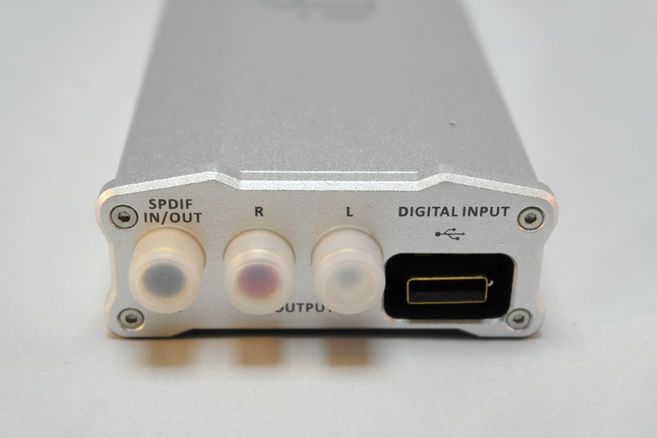
Back
Battery Life
Battery life is estimated to be just around 6 hours with Turbo mode, 9 hours for Normal mode and 12 hours with Eco mode, plus or minus an hours or so depends on different condition and load of course. The battery life isn’t exactly long per se, but it is price you have to pay for having such a huge amount of output power for portable use.
Another thing about the battery is that it has its own smart circuit to control the charging. To speed up the charging, you need to plug the micro iDSD into a BC1.2 complied USB port. A regular USB port will work just as well, as long as the iDSD is turned off and you don’t mind a bit longer charging time. If the iDSD remains on, a regular USB port might not output enough current to both charge and power iDSD at the same time, so it might drain off the battery slowly. Whether it will drain or charge really depends on how much power your USB port can pump out. Again, a BC1.2 complied USB port (or hub) is your best bet. Last but not least, the smart circuit also turns micro iDSD into a USB power bank when (and only when) it is turned off. Just plug any USB device on to the USB port on the side of micro iDSD and it will charge it up. Needless to say, this will eat into micro iDSD’s play time.
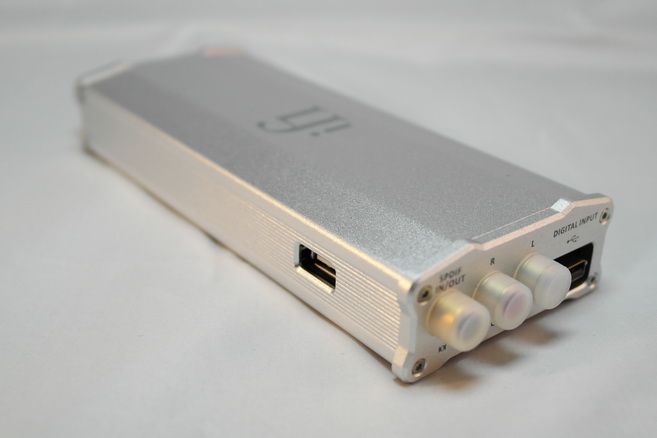
SmartPower Socket on the side
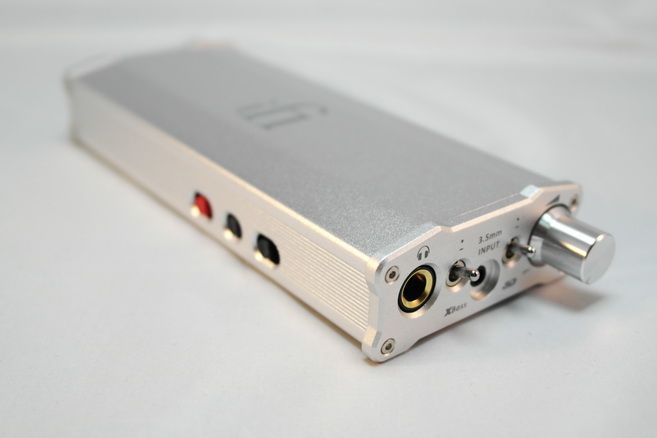
Gain, Polarity and Filters selection on the side.
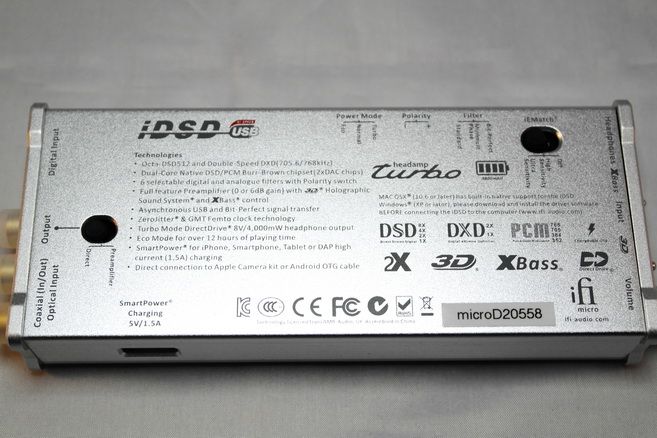
iEMatch and RCA-out selection on the bottom.
Gain, Hiss and EMI
There are two way of adjusting gain on micro iDSD: the power mode and the iEMatch. According to my own measurement, the Eco mode is just under 1dB of gain, Normal mode is around 9~10dB of gain where Turbo mode gives you around 15~16dB gain – and this is the same whether you are using micro iDSD as DAC+amp or as pure amp. iEMatch on the other hand is doing just the opposite by lowering gain: the Off setting doesn’t do anything, where High Sensitivity setting is about -11.4dB and Ultra Sensitivity setting is about -24dB. The recommended way of adjusting gain is that you start with the power mode first. If you still find Eco mode too loud, then you adjust the iEMatch. For example, it doesn’t make any sense to use Turbo mode with Ultra Sensitivity since you will end up getting roughly the same gain as Normal mode without iEMatch, yet wasting a lot of battery power in the process. Last but not least, there is also the pre-amp mode which you can set for the RCA output and it has a 9dB gain (roughly equal to Normal mode). That is mainly for using iDSD as a preamp feeding into a power amp, and you get to use the loudspeaker version of XBass and 3D Holographic Sound effect as well (which we will discuss more on the next section).
Hiss is not an issue for micro iDSD at all as I can’t even detect any obvious hiss on Turbo mode with my most hiss prone IEM. EMI is very mild too and hardly a concern at all. Even with Turbo mode, it is about as loud as someone whispering next to your ear.
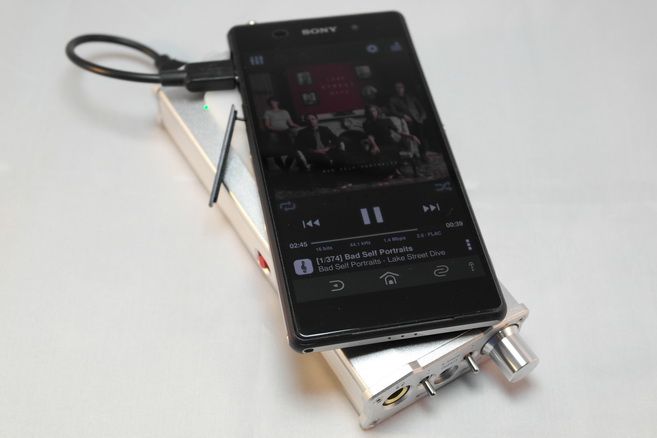
Sony Xperia Z2 feeds into micro iDSD via USB OTG cable
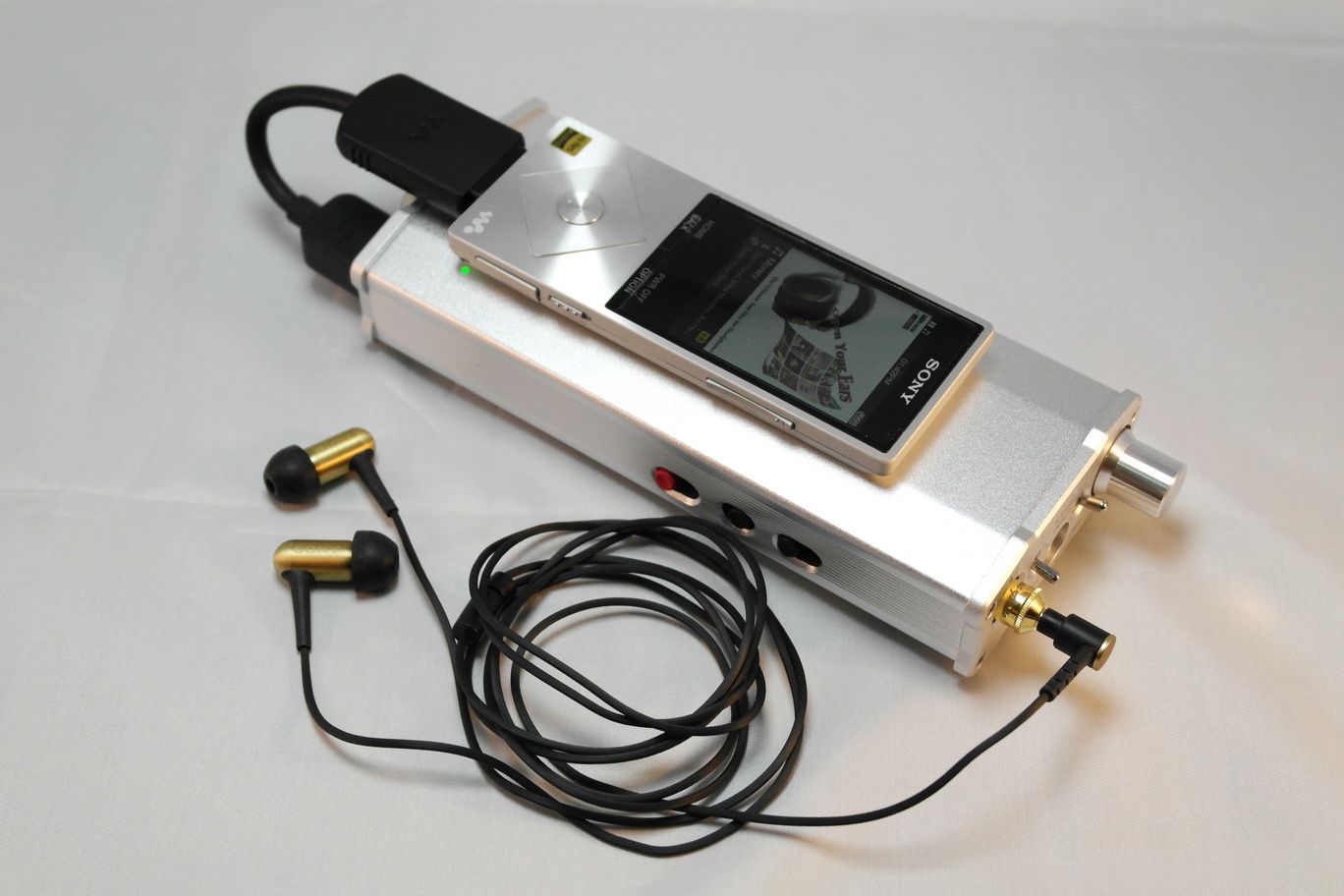
Sony NWZ-A15 feeding into micro iDSD via WMC-NWH10 cable
Sound Quality and EQ
As usual, we start with some basic measurement. RMAA reveals no problem as far as frequency response, noise and distortion go. In fact, the measured difference between Eco, Normal and Turbo mode is pretty small as well, which is a very good thing as higher gain doesn’t seem to degrade SQ much. Line-out voltage is about 1.95Vrms or so, where max voltage on headphone-out goes from just a little above 2Vrms in Eco mode to over 11Vrms in Turbo mode (*no load, and it might go lower with load, as indicated by iFi). Measurement over current output shows that it has plenty of power regardless of which gain mode it is in. With iEMatch sets to off, output impedance is under 1 ohm. On High Sensitivity, it is around 4 ohm or so. With Ultra Sensitivity, it goes back down under 1 ohm again. Also, High Sensitivity roughly cuts the output power by half with the same volume as the Off setting, though Ultra Sensitivity only cuts about 1/5. The main reason for more loss of power on High Sensitivity probably has to do with its higher output impedance, if anything else. Regardless, both High and Ultra Sensitivity still maintain more than adequate amount of power to drive IEM with good authority.
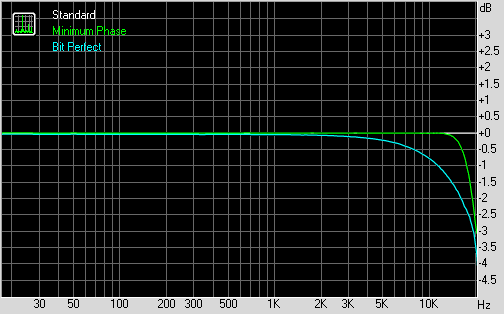
The Three PCM filters @ 16/44.1
Another user selectable option on the micro iDSD that will affect SQ is the filter selection. Filter is needed because the DAC’s sampling process will produce high frequency noise above the audible range. Even though it is mainly on the inaudible range, its effect will still reach under 20kHz and therefore we need filter to cut them off. With PCM decoding, the filter switch changes between three different digital filters setting: Standard, Minimum Phase and Bit Perfect. Standard filter is also known as ‘fast roll-off’ sometime, which has a shaper cut –off frequency, offer a flatter FR curve and nicer measurement. But it is often also regarded as being harsher and grainier sounding. Minimum Phase is what known as ‘slow roll-off’ by some, and usually offer a smoother sound but comes with a slight -3dB roll off between 14kHz to 20kHz. It is probably one of the most common filter found on higher end DAC because it is regarded as the best compromise between measurement and human perception. Bit Perfect on the other hand is actually not a filter at all. It is more commonly known as Non-OverSampling, or NOS for short. As the name implies, it is where the DAC doesn’t oversample the signal and doesn’t use any digital filter. The resulted FR curve has a rather big -3dB roll-off going from upper midrange all the way to 20kHz. NOS is in itself too complex a topic for us to cover here - but the basic idea is not to oversample the signal as would be done on normal DAC. Instead, the sampling is carried out where the focus is to restore the musicality back to the signal rather than to achieve the highest accuracy on frequency response. The result is often being described as a sound that is more analog and natural, though doesn’t measure nearly as good as the other two filters and can sound slightly hissy with sensitive headphone due to the lack of filter. To put it short, you can think of the three filters as going from what measured best to what perceived best. With DSD decoding, the same filter switch change to three analog filter selection: Standard, Extended, and Extreme. Due to its 1 bit nature, DSD can’t employ any digital filter (which we will discuss further in the next section on native decoding). Therefore it can only use analog filter after the decoding. The three settings are mainly to determine where to set the cut-off point along the frequency response. Last but not least, DXD only gets one setting and it is Bit Perfect / NOS, therefore it doesn’t matter which position the switch is in. So, you might start to wonder which filter sounds best? Well, the whole point of having a filter selection is so that you can find out the answer for yourself. It isn’t about right or wrong but about your own preference. However, for the purpose of the review, I have used the Standard filter for most of the measurement as well as majority of the subjective listening. Of course, this doesn’t actually mean I prefer the Standard filter more.
Last but not least on the user selectable switch that affects the SQ is the polarity. The short story it is that someone once found out that his music has been recorded in reversed polarity (which most human are not very sensitive of), then reversing the polarity will restore back what the music should have sounded like. In the ‘+’ position, the music will pass through iDSD as it is; in ‘-’ position however, the polarity will be reversed. I can’t really tell the difference myself, but don’t let me stop you from trying it out for yourself. If you are like me, just leave it at ‘+’ should be fine.
Now let start with the subjective listening – and let get this out of the way first: while micro iDSD can be used as a pure amp, it is not really the best portable amp you can buy for the price. While the amp section is excessively powerful and can drive even fairly inefficient planar magnetic headphone to quite a good level, it has a noticeably drier and brighter sound signature with some of the texture over lower mid to bass range missing. However, micro iDSD isn’t a bad sounding amp either. I would think the amp section alone is good enough to match any upper second tier portable amp or even lower top tier portable amp. It is just not enough to truly being referred as a top tier portable amp on its own.
As I have written on my review on nano iDSD, I often find portable DAC+amp combo either has a good amp but an only a decent DAC, or the other way around with a good DAC but just an okay amp section. On the micro iDSD however, I really don’t find the amp section to be the limiting factor at all – yes, it isn’t the best amp section ever. But it does have really good synergy with the DAC section, where the slightly drier amp is compensated by the slightly warmer DAC and they end up being smooth and fairly neutral sounding, if not just a bit on the richer and fuller side of the presentation. In other words, the sonic characteristics of the famous Burr Brown sound that is supposed to be warm and thick are not lost in the process, but tuned down a little and become more adaptive as a whole when it comes to synergy and headphone pairing. Of course, you are really craving for the full Burr Brown treatment, the RCA-out still offers a chance for you to feed micro iDSD to an amp of your own choice. That being said, the line-out from micro iDSD is indeed excellent. It rivals just about every USB DAC I have heard before, desktop or portable. Though I do want to point out I really haven’t heard any of the multi-thousands DAC that I can’t afford anyway, so it is not to say micro iDSD is the be-all-end-all of DAC.
One other thing I really love about the micro iDSD is that it is optimized for OTG usage. In my case, it works with both my Sony Xperia Z2 as well as Sony NWZ-A15 DAP without any problem. Sony already has a special USB driver implemented on their latest Android flagship smartphone, which upsamples everything to 24/192, and it works flawlessly with micro iDSD without the need of any extra app. Of course, if you have either USB Audio Player Pro, Onkyo HD Player or Hiby Music player, you can also play DSD files on iDSD as well using DoP protocol. The A15 player however isn’t Android based. But it does support USB OTG with a special cable (Sony WMC-NWH10) and has no problem working with micro iDSD to create probably one of the best sounding portable ‘stack’ in the market, rivaling high end audiophile digital audio players like HiFiman and Astell & Kern. I was, on two occasions, also able to compare micro iDSD to the much more expensive and very well regarded Chord Hugo (both fed by the same digital source). While Hugo carries a much more euphonic presentation, I don’t actually find it to be technically better than iDSD. One might like the flavour Hugo adds to the music, but it is really more of a flavour to me rather than a true rendition of what is intended, not to say that it isn’t an absolute great flavour on its own right. I personally thought that this is a good indication on micro iDSD’s ability to play on a much higher level of playfield than what its price tag would have otherwise suggested.
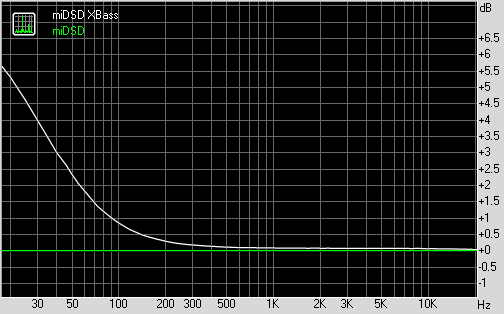
XBass
Micro iDSD, like micro iCAN, comes with both XBass and 3D Holographic Sound. Unlike iCAN’s two level selection however, they only have one setting on iDSD – on or off. The effect is somewhat in between iCAN’s two levels. iFi’s reasoning is that they don’t want to have too big or small an effect as people might find it either too much or too little. Thus they opted for the middle ground. To me, the effect on XBass is indeed a little too subtle. It seems to work fine on some of my IEM but less noticeable on other. 3D Holographic Sound on the other hand has a bit more noticeable impact, which the IEM user in me does like it quite a lot (*given most IEM never really have good soundstage to begin with). Last thing to note is that both XBass and 3D Holographic Sound also work on variable RCA-out (*preamp mode), but they are tuned differently from the XBass and 3D Holographic Sound on headphone-out as they are intended to be fed to power amp and eventually loudspeaker. So if you are feeding the variable RCA-out to a headphone amp (then to a headphone of course), the EQ might not sound right, especially with 3D Holographic Sound.
Extra: Native vs Non-Native Decoding
When it comes to DSD playback, the words ‘native decoding’ has been threw around fairly casually by many manufacturer. The fact is however, many of them isn’t as ‘native’ as you will like to believe and often some form of internal conversion has been employed. To really understand whether a DAC really is natively decoding DSD or PCM, often you need to look beyond words but inside the circuit design on the chip’s level. Unfortunately for most of us, that’s just impossible as manufacturer would rather not share with everyone their trade secret. I won’t try to cover the whole topic here as it is such complex an issue that it will probably take an expert a lot more inks than what this review is intended for, and I am no expert on this topic either. But luckily Mr. Thorsten Loesch, the designer of micro iDSD, has already written such an article. While it is about nano iDSD, the same blood is in the vein of micro iDSD as well. Therefore what has been said on that article is just as true for micro iDSD as it is for nano iDSD. Read it here: http://www.audiostream.com/content/qa-thorsten-loesch-amrifi
The take-away point is - with the complexity and uncertainty in recording and mastering of the music before it reaches our ears, it is best to keep thing as ‘native’ and as non-invasive as possible when it comes to converting the 1 and 0 back to analog sound. That’s perhaps the reason why iFi has insisted on using the Burr Brown DAC rather than opts for something new and shiny with a more ‘marketable’ nametag. In that sense, I think they have done a tremendous job on optimizing the Burr Brown DAC to make it just as relevant as any top-of-the-line DAC chip in the market right now.
Sum-up
Is micro iDSD the perfect portable DAC+amp? No. If I can have a wish list, I’ll like it to be smaller, lightly, slimmer, shorter and perhaps, a true top tier amp as well. But the one thing that can’t be denied, nor would I wish to change, is the fact the micro iDSD is packed full of value and performance. If you ever need a portable USB DAC + amp that can just about do it all, do it well, and do it without costing a limb, I reckon this is /it/.
A thanks to iFi Audio for the review sample.





